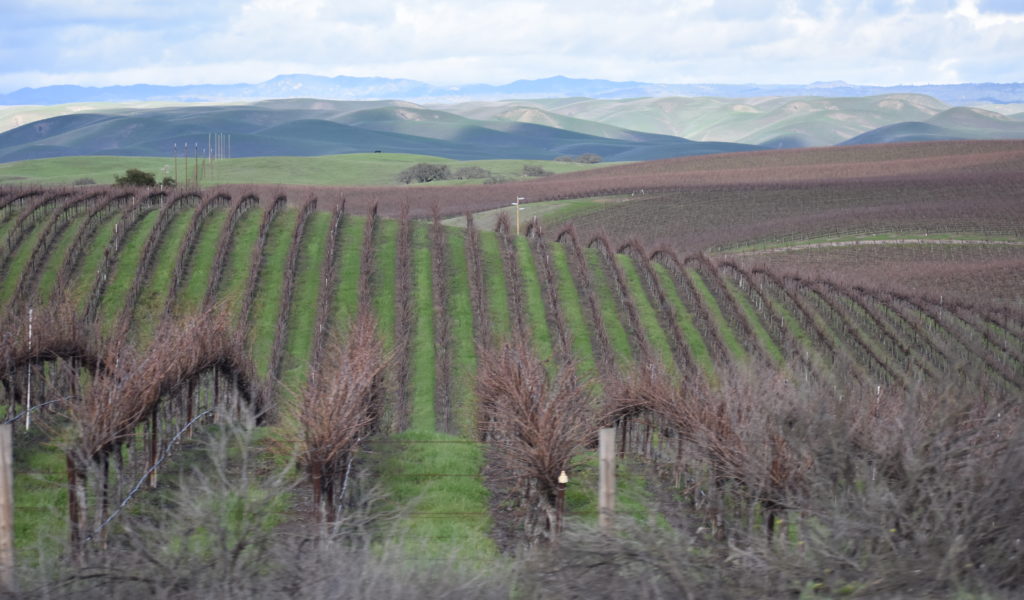Polyculture Farming Must Serve As The Foundation
Posted on January 17, 2018 by KK
Leave a Comment
Last January I went on a road trip across California with my brother Adam in my Aunt and Uncle’s VW Camper. I remember the awe we experienced as we gazed out the window at hundreds of acres of grapevines young and old. As we traveled along the countryside and outskirts of cities, we tactfully dodged mudslides in Big Sur, flooding, 80 mph winds in San Luis Obispo, where we hunkered down for the night at the El Chorro Regional Park next to the Botanical Garden, and a snow storm in Yosemite. Luckily the highway apps allowed us to safely maneuver our way between two beautiful National Parks in the winter. If you haven’t visited Yosemite or Joshua Tree National Parks, they must be on your bucket list!
I never really thought to consider viticulture as a thriving monoculture movement until I was bombarded with rows of vineyards in my peripheral view. Just as the picture indicates, there’s a succinct system in play within the viticulture industry and it’s hard not to miss the lack of biodiversity in this industry alone. While there is a cover crop of grass in between the rows, there are other solutions that could be utilized to make verticulture production more sustainable. Encouraging organic viticulture is an ongoing debate but there are winerys all over the globe that work with nature to create a wine that is better for all living things.
In the twenty-first century the “tri-lemma; food, fuel, and the environment,” are the driving forces that should propel biodiversity and agrobiodiversity. Power postulates that innovation is thwarted by decisions that farmers must make in response to policies and market trends, with landscape changes devised to meet these demands (2009). Power presents the dilemma that ecosystem services must support and detract between agricultural services and ecosystem services, and that they must be supported by biodiversity (2009). I believe that farming methods used to cultivate crops, like polyculture vs. monoculture, play an essential role in biodiversity and agrobiodiversity.
Ecosystem services must incorporate polycultural agricultural systems in order to build the foundation for more sustainable food systems. Landis, Wratten, and Gurr (2000) previously discussed how monocultural cropping systems prevent the occurrences of beneficial insects to run their course due to the use of pesticides, and how polycultures provide a welcoming environment for multiple species to coexist and work with nature over time. Polycultural farming methods should serve as the foundation of policies and programs.
Agricultural systems are implemented as a result of agricultural practices driven by the demand in global markets (Power 2009). Agricultural systems must support alternative landscapes like permaculture in order to be effective at maintaining conservation, resource recycling, and water harvesting, while creating more biodiversity (Conrad 2013). Hesterman states that we are chipping away at transforming the food system through a systems change, emphasizing that we can’t afford to wait, “we need to act more directly and forcefully now” (Oran B. Hesterman 2011, 43). Furthermore, policies should mandate that farms incorporate “adaptive landscaping” (Power 2009) on their farms in order to receive funding, and claim agricultural exemptions. Insisting that giant monoculture viticulture farms adhere to biodiverse systems would provide more sustainable solutions for dealing with drought.
Bibliography
Conrad, Abigail. “The benefits of alternative farming methods.” The Guardian. April 23, 2013. http://www.theguardian.com/global-development-professionals-network/2013/apr/23/farming-methods-agroecology-permaculture (accessed October 10, 2014).
Douglas A. Landis, Stephen D. Wratten, Geoff M. Gurr. “Habitat Management to Conserve Natural Enemies of Anthropod Pests in Agriculture.” Annual Review Entomol (Annual Reviews) 45 (2000): 175-201.
Oran B. Hesterman, PhD. Fair Food. Philadelphia: PublicAffairs, 2011.
Power, Alison G. “Agricultural Systems and Ecosystem Services: Trade-offs or Synergies?” Twenty-First Century Ecosystems: Systemic Risk and the Public Good . The National Academies of Sciences Engineering and Medicine, February 12, 2009.

